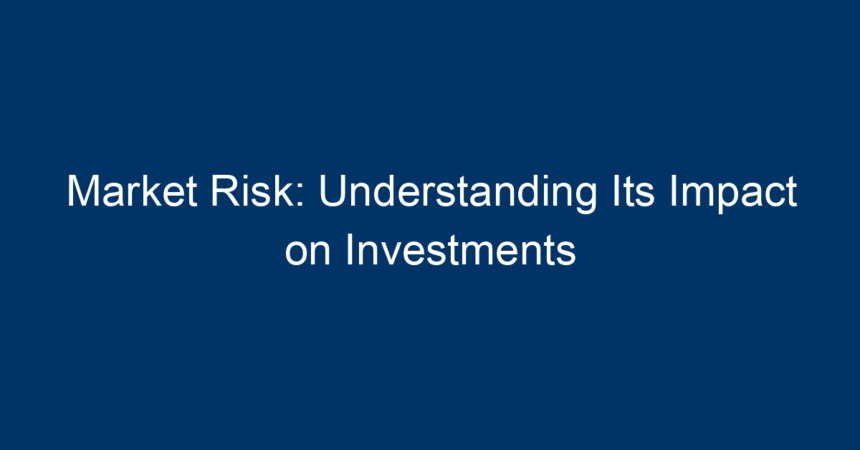In the vast and intricate world of finance, the term market risk evokes a spectrum of emotions among investors—fear, anxiety, and sometimes, a sense of opportunity. But what is market risk, and how does it influence the decisions of investors, both seasoned and new? Understanding market risk is crucial for anyone looking to navigate the tumultuous waters of investing. In this article, we will explore the concept of market risk, its types, impacts on investments, and actionable strategies to manage it effectively.
What is Market Risk?
Market risk, also known as systematic risk, refers to the potential financial loss that investors face due to factors affecting the entire market or a significant segment of it. Unlike specific risks tied to individual assets or industries, market risk impacts all investments, regardless of their nature. This explains why stock prices can plummet during economic downturns, regardless of a company’s fundamentals.
Key Attributes of Market Risk
-
Non-Diversifiable: Unlike unsystematic risk, which can be mitigated through diversification, market risk cannot be entirely avoided. Every investor is subject to the market’s fluctuations.
-
Influenced by External Factors: Market risk is heavily influenced by broad economic factors, including interest rates, inflation, geopolitical events, and technological changes.
- Impact on Portfolio: Market risk significantly affects asset classes across the board, from stocks and bonds to commodities and currencies.
Types of Market Risk
Understanding the types of market risk is essential for effective investment strategy formulation. Here are the primary types to consider:
1. Equity Risk
Equity risk pertains specifically to investments in stock markets. This risk arises from changes in stock prices due to market sentiment, changes in corporate governance, or market trends. For example, a sudden market crash can lead to a significant decline in stock values, impacting individual portfolios.
2. Interest Rate Risk
Interest rate risk affects investments in bonds and other fixed-income securities. When interest rates rise, bond prices typically fall, leading to potential losses for holders of those bonds. This type of risk is crucial for fixed-income investors to monitor closely.
3. Currency Risk
For investors engaging in foreign markets, currency risk becomes a significant concern. Fluctuations in currency exchange rates can lead to unpredictable returns. For example, an investment in a European company can become less valuable if the Euro declines against the U.S. Dollar.
4. Commodity Risk
Investors in commodities such as oil, gold, or agricultural products face commodity risk. Changes in supply and demand dynamics, weather conditions, or geopolitical tensions can affect commodity prices dramatically.
5. Systematic Risk
Systematic risk is the broader category encompassing all types of market risks. It affects the entire market and is usually a result of economic changes, major political events, or natural disasters.
The Impact of Market Risk on Investments
Market Volatility and Investor Behavior
Market risk translates directly into volatility. Volatile markets can trigger panic selling or hasty decisions among investors, leading to potential losses. Understanding market trends and investor behavior can aid in navigating these periods of uncertainty.
Long-term Investment Strategies
While market risk is inevitable, its impact can vary based on investment timelines. Long-term investors often adopt a “buy and hold” strategy, which can buffer against short-term fluctuations. Historically, markets have tended to recover over time, giving investors reason to maintain their strategies despite market turbulence.
Asset Allocation and Diversification
Effective asset allocation is fundamental to managing market risk. By distributing investments across various asset classes—such as stocks, bonds, and real estate—investors can mitigate the impact of market downturns. However, it is essential to understand that diversification cannot eliminate market risk entirely, but it can help cushion against adverse conditions.
Strategies to Mitigate Market Risk
1. Stay Informed and Educated
Awareness of market trends, economic indicators, and geopolitical events is vital for investors. By staying informed, individuals can make better decisions and respond quickly to market changes.
2. Utilize Hedging Techniques
Hedging is an investment strategy aimed at offsetting potential losses. For instance, options and futures contracts can be used to hedge against declines in asset prices. This approach requires a good understanding of financial instruments and market behavior.
3. Consider Defensive Investments
Defensive stocks, such as those in essential goods and services sectors (utilities, consumer staples), tend to remain stable during economic downturns. Investing in these sectors can reduce exposure to market risk during volatile periods.
4. Regularly Review and Adjust Your Portfolio
Periodic review of one’s investment portfolio helps to identify areas that may need adjustment based on market conditions. Rebalancing a portfolio to maintain desired asset allocation can help manage market risk effectively.
5. Employ Dollar-Cost Averaging
Dollar-cost averaging involves consistently investing a fixed amount of money over time, regardless of market conditions. This strategy helps reduce the impact of volatility, smoothing out the purchase price over time.
Conclusion: Navigating Market Risk
Understanding market risk is essential for anyone involved in investing. Whether you’re a novice looking to build a portfolio or a seasoned investor refining strategies, recognizing the types of market risks and their potential impacts is vital.
Investors can employ various strategies—from staying informed to implementing hedging techniques—to manage market risk effectively. By diversifying investments and periodically reviewing portfolios, you can navigate the unpredictable nature of financial markets while safeguarding your assets.
Ultimately, the key to successful investing lies in acknowledging market risk, preparing for it, and adopting a proactive approach to managing it. With the right mindset and strategies in place, investors can seize opportunities and better weather the storms of market volatility.
By making informed decisions and continuously educating themselves about market dynamics, investors can turn potential risks into manageable challenges, ensuring their financial futures remain bright.




